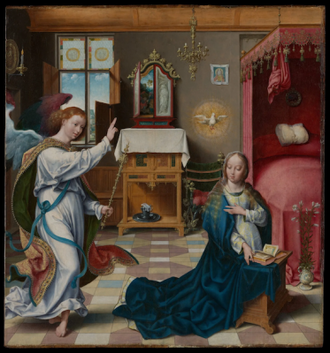Gospel in Art: Mary said 'let what you have said be done to me'

The Annunciation, by Joos van Cleve, 1525 © Metropolitan Museum, New York
Source: Christian Art
Gospel of 20 December 2023
Luke 1:26-38
The angel Gabriel was sent by God to a town in Galilee called Nazareth, to a virgin betrothed to a man named Joseph, of the House of David; and the virgin's name was Mary. He went in and said to her, 'Rejoice, so highly favoured! The Lord is with you.' She was deeply disturbed by these words and asked herself what this greeting could mean, but the angel said to her, 'Mary, do not be afraid; you have won God's favour. Listen! You are to conceive and bear a son, and you must name him Jesus. He will be great and will be called Son of the Most High. The Lord God will give him the throne of his ancestor David; he will rule over the House of Jacob for ever and his reign will have no end.' Mary said to the angel, 'But how can this come about, since I am a virgin?' 'The Holy Spirit will come upon you' the angel answered 'and the power of the Most High will cover you with its shadow. And so the child will be holy and will be called Son of God. Know this too: your kinswoman Elizabeth has, in her old age, herself conceived a son, and she whom people called barren is now in her sixth month, for nothing is impossible to God.' 'I am the handmaid of the Lord,' said Mary 'let what you have said be done to me.' And the angel left her.
Reflection on the painting
After the Angel of the Lord appearing to Zechariah in yesterday's Gospel reading, today we read how the Angel Gabriel was sent by God to Mary. Mary was completely open to God's purpose for her life, as she says to God's messenger, Gabriel, 'Let what you have said be done to be''. Mary gave herself over completely to God's will for her to become the mother of his Son, with all that would imply for her. This would bring some of the most joyous days of her life, but also some of the most tragic, well beyond what anyone could ever have imagined.
In our painting by Joos van Cleve, circa 1525, we see the angel Gabriel and Mary set within an elaborately furnished interior that would have been familiar to 16th-century viewers. However, most of the objects, arranged unobtrusively within the room, carry symbolic meaning. The altarpiece and the woodcut on the wall, for example, show Old Testament prophets as prefigurations of New Testament themes. A portrait of Moses is hanging on the back wall. The lily, a traditional symbol of purity and innocence, is depicted close to Mary. The Holy Spirit, symbolised by a dove, is depicted descending towards Mary. The open book in Mary's hands symbolises her receptivity to the divine message. A candle in the top left corner is shining brightly.
It is a beautiful, intimate portrait of the Virgin and Gabriel in a domestic setting. Placing the Annunciation in a domestic setting reinforced the theological concept of the Incarnation-the belief that the divine became human in the person of Jesus Christ. Mary's acceptance of the angel's message within this ordinary home setting highlighted the miraculous union of the divine and the human in the person of Jesus. Furthermore, the choice of a bedroom or a domestic interior emphasised the humanity of Mary and conveyed the idea that profound spiritual events could occur in the midst of everyday life... which indeed they do!
A lot was being asked of Mary and it would make great demands on her, but she was not being asked to take on this task of being mother to God's Son in the strength of her own resources alone. With this reassurance, she surrendered to the demanding role that God was giving her. She accepted all... all out of love.
LINKS
Gospel in Art: https://christian.art/
Today's Reflection: https://christian.art/daily-gospel-reading/luke-1-26-38-2023-3/





















